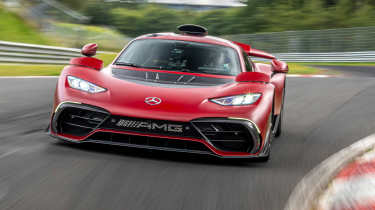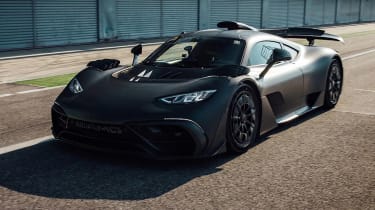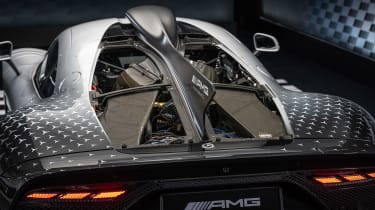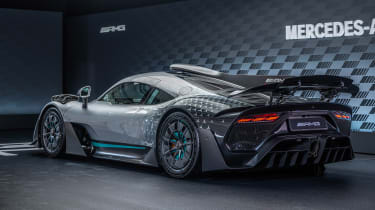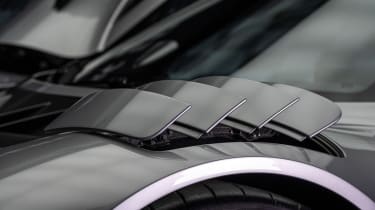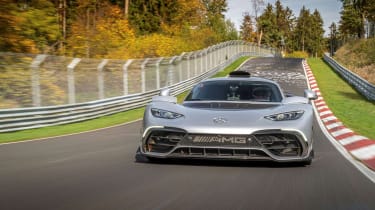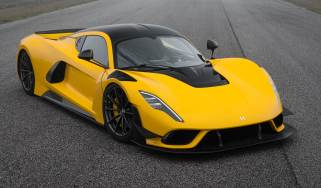The Mercedes-AMG One has broken its own Nürburgring lap record
Maro Engel has once again driven AMG’s F1-derived hypercar to a new Nürburgring record, setting a time of 6:29.09
Following its record-breaking Nürburgring lap in 2022 (and another record at Monza last year), the Mercedes-AMG One has once again set the benchmark for production cars around the gruelling Nordschleife loop. AMG ambassador Maro Engel has driven the F1-engined hypercar to a 6:29.09 time, beating the One's previous record by over five seconds.
The lap was completed with an AMG One in standard road-going specification. As has been well documented, the car uses a 1.6-litre V6 engine derived directly from Formula 1 and three electric motors, together producing 1048bhp.
This enormous power combines with a state of the art aero package that includes active aero elements around the nose, front wheel arches, rear diffuser and rear wing. It’s this combination that enables the One to perform to such a high level around the Nürburgring, sitting head and shoulders above other road car lap times.
Due to the way the hybrid powertrain delivers its performance, Engel didn't just have the task of driving the One flat-out; he also needed to manage the powertrain’s battery consumption to ensure maximum performance on the circuit’s higher-speed sections. Simulator tests determined the optimal areas for him to lift-and-coast to save energy around the lap, which he then implemented during the run.
'Two years ago, the conditions were not ideal, and some sections of the track were still a little damp,' said Engel. 'We knew we could do more, and we wanted to show that. Today we were able to demonstrate the maximum potential of the AMG One. Many thanks to the whole team from Affalterbach for the trust they’ve placed in me. It was a great pleasure and honour to be able to drive this record lap with such a unique car.'
Of course the AMG One’s hypercar rivals, such as the Aston Martin Valkyrie, are yet to attempt their own lap times, but we can consider the gauntlet thrown down for a new era of Nürburgring record attempts.
Mercedes-AMG One – production
After over half a decade of intensive development, the Mercedes-AMG One is now officially in production. AMG has partnered with Canadian outfit Multimatic in the setup of a small production facility in Coventry, where all 275 units will be assembled. The One's F1-derived powertrains will come from down the road at Mercedes F1's Brixworth-based engine works, creating what will become Mercedes-AMG's most extreme road car ever.
First customers have already received their cars, each not just employing F1-inspired engineering, but a literal sister unit to the engine that's helped Mercedes-AMG Petronas win eight constructors championships. There’s been plenty of controversy around its development, and its Aston Martin Valkyrie rival, but now we can reveal the technical details and numbers for the cars we’ll see on road.
Drivetrain
What marks out the One from the hypercars before it is the drivetrain. Be in no doubt that the ‘Formula 1 car for the road’ tag line isn’t just marketing guff. It’s a fact. Aft of the passenger cell you’ll find a version of the F1 car’s EQ POWER+ powertrain that has propelled Mercedes to eight consecutive F1 constructors titles, five more than when the Project One was originally announced.
The 1599cc V6 petrol combustion engine is built in the same AMG Engine Works facility in Brixworth that builds the Mercedes F1 engines, and is supplemented in the One by four electric motors that all combine to deliver a 1048bhp maximum power figure. As with all hybrids, the peak power is not a simple sum of all the contributing elements, but the peak figure available from all the elements at any one time.
The V6 itself is rated at 565bhp generated at 9000rpm, with a peak rev limiter of 11,000, or 2500rpm less than Hamilton’s Sunday driver. This equates to a specific output per litre of 359bhp – a Mercedes-AMG A45 S is 208bhp/litre for contrast, and even something as highly strung as the Koenigsegg Jesko (which has yet to prove reliable) doesn’t quite match the AMG with 313bhp/litre.
So it’s a pure F1 engine, then? Not exactly. AMG calls it a ‘bespoke unit’ that marries elements from multiple generations of its F1 engine. The engineering is exactly the same, though. Air is fed into the engine by a combined mechanical and electrically-driven turbocharger with the exhaust turbine located near the exhaust and the compressor near the roof-mounted air intake. They’re joined by a long shaft to which is connected an 80kW (121bhp) MGU-H electric motor. This primes the turbocharger to eliminate lag and, according to AMG, gives the V6 faster responses than a naturally-aspirated V8. The electric motor also recovers waste exhaust energy which can then be used to replenish the hybrid battery or directly drive the MGU-K.
MGU-K? It stands for Motor Generator Unit Kinetic, another electric motor positioned on the side of the crankcase and directly connected to the crankshaft. It can either drive the crankshaft, adding 120kW (160bhp) to the power tally, or be driven by it. AMG claims that the combined petrol-electric elements working as a complete unit achieve an unprecedented thermal efficiency of around 40 per cent against a norm of 30-32 per cent. It’s as close as you’ll get to guilt-free 1000hp+ motoring.
Sitting behind the engine is a bespoke seven-speed, single clutch transmission and a limited-slip differential. Above that is the exhaust system which, unlike the F1 car's version, has a silencer, catalytic converter and two petrol particulate filters which make the One Euro6 emissions compliant – a consideration AMG might not have made when the project was initiated all those years ago.
From here, there are then two more electric motors that power the front axle, which together produce 240kW (321bhp). These power each front wheel independently, and allow complete torque vectoring. The lithium ion battery cells - their configuration, connectors and direct cell liquid cooling - are a direct lift from F1. However, the 800-volt high voltage system (contained in two battery housings on each side of the car) has around four times the capacity used in F1 at 8.4kWh.
The higher voltage level reduces voltage losses, not least in the cables. It also allows significantly shorter charging times with a constant current level. The One’s driving programs will even have an all-electric mode with just the front axle driven, giving a range of up to 11 miles. The most extreme ‘dynamic’ mode, on the other hand, will adopt settings used in F1 to achieve the best possible lap times in qualifying.
Though an impressive feat, its complexity certainly hasn't helped its weight figure. The Mercedes-AMG One tips the scales at 1695kg (DIN), a few hundred more than even previous-generation hybrid hypercars such as the McLaren P1. For context, that gives it a 618bhp per tonne power-to-weight ratio, just 55bhp per tonne more than the £280,000 McLaren 765LT.
As a result, performance figures aren't as mind-boggling as you might expect for a £2.5million machine. 0-62mph comes in 2.9sec to match the Ferrari F8 Tributo, with the 7sec 0-124mph time only enough to level with the McLaren 765LT – top speed comes at 219mph.
Chassis, brakes and wheels
The five-link suspension system is a horizontally-packaged, pushrod damper setup with coilovers and three-way adjustable dampers. The setup negates the need for a traditional anti-roll bar up front, preventing lateral roll and disassociating lateral movements from vertical movements. The suspension is also able to be hydraulically lowered by 37mm in its most aggressive track mode.
The chassis itself is derived from a carbon monocoque with an aluminium front subframe. Like F1 cars, and some of the really serious supercars, the rear-mounted gearbox and limited-slip differential act as stressed members of the chassis, to which the rear suspension is directly mounted.
The brakes are carbon-ceramic and, thanks to the relative lack of mass, are a surprisingly restrained six-piston setup up at the front with 398mm discs, and four-piston calipers on 380mm discs in use out back. There are two wheel designs available, both coming with their own clever carbonfibre aero devices. The standard set is a 10-spoke design made from forged aluminium, the optionals being a 9-spoke Magnesium design. The wheels are staggered in diameter and width – the fronts are 10x19-inch on 285/35 ZR19 rubber, with 12x20-inch units on 335/30 ZR20s at the rear. The tyre of choice is a Michelin Cup 2R.
Active aerodynamics and design
While the powertrain is a homage to Formula One and the chassis an exercise in contemporary hypercar engineering, the active aero is a vision of the future, with moveable elements all over the AMG One’s surface. There are three main active aero elements on show – moveable flaps built into the front diffuser, front wheel arch vents and the moveable rear wing. The splitter and rear wing are elements we’ve seen before, both working in tandem to either increase downforce or reduce drag.
The mechanical flaps on the front wheel arches are different, though, opening to reduce internal pressure within the wheel wells by extracting air through them. Unlike the other active aero parts, though, there’s no real advantage to those elements being closed as they offer no benefits aside from perhaps keeping dirt and grime within the arches, making them more of a visual statement than a big leap in aerodynamic efficiency.
The engine cover is a two-piece unit that flanks the central fin which is formed from the tail-edge of the roof-mounted intake. Both parts are solid carbonfibre, but have vanes for heat extraction and two massive NACA ducts that should help keep the engine bay cool. With such a highly-strung nature to its F1-derived engine, the AMG One’s cooling requirements are extreme, explaining the intensive focus of cooling and aero management.
The design is otherwise largely unchanged from that initial concept car we saw in 2017, including the pared-back interior and F1-inspired steering wheel. While it’s not the prettiest supercar in the world, it does look extremely focused, while still incorporating a range of AMG design elements that even now are still relevant to the current AMG range. However, the car’s journey from 2017 to now hasn’t always been smooth sailing, making the AMG One’s backstory one that’s just as fascinating as the car itself.
The complex and controversial backstory
In 2017, Tobias Moers was head of AMG and the F1 team was at the height of its dominance. Electrification was in the distant future, and the premium segment produced huge sales volumes, giving Mercedes-Benz and many of its rivals an extremely healthy outlook into the near future.
In the hypercar space, McLaren, Porsche and Ferrari had hogged the limelight with the P1, 918 Spyder and LaFerrari, and AMG wanted in, so came up with the idea of the Project One, a design that utilised its championship winning engine in a production car. This was an enthusiasm shared by Aston Martin, then led by Andy Palmer. Aston's partnership with the Red Bull F1 team spawned its own F1-inspired hypercar that, like the AMG, would also go much further than the previous hypercar generation. The two projects would create the AMG Project One and Aston Martin Valkyrie rivalry that’s still at play today.
Unfortunately, the good times were not to last, as development on both projects hit multiple snags, for quite different reasons. AMG’s issues were surrounding the powertrain, which was proving especially difficult to convert to road car use on account of its inherently highly strung nature. F1 engines, while more resilient than previously, are still designed for a life-span of a few thousand miles, not the tens of thousands expected from a road car – even one as specialised as this. To make matters more complicated, Mercedes and Aston Martin had been tightening their relationship, collaborating both on and off the race track, making the vanity project against Aston Martin now an almost internalised battle, one with no winners.
Fast forward past Aston Martin’s disastrous IPO, Mercedes-Benz purchases an even bigger 20 percent stake in the British brand, eventually leading to the appointment of ex-AMG boss Tobias Moers as Aston Martin CEO, taking over the role from Andy Palmer.
This left the new boss of Aston Martin to forge ahead with the Valkyrie that would go head-to-head with his own passion project, the AMG One. To make matters more complicated for Moers, Aston Martin would then dissolve its partnership with Red Bull in F1, creating instead its own team from Racing Point, which itself was built up by new Aston Martin Chairman Lawrence Stroll.
Yet both projects continued on, albeit with substantial delays, with the AMG One and Valkyrie eventually reaching customers. Despite the narratives of both these hypercars becoming muddled up by company politics, the saga has left us with two of the most fascinating road car projects the car industry has ever seen.
